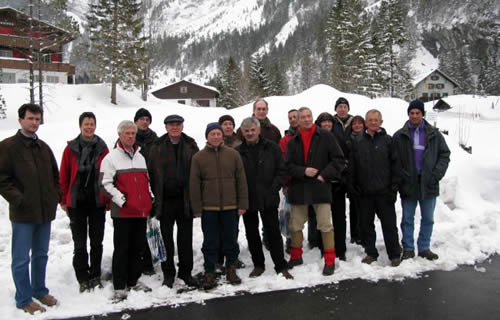
2nd Joint EPPO/IOBC Panel Meeting on Biological Control Agents
Engelberg (CH), 2009-03-25/27
This meeting took place in Engelberg (CH) and members from the EPPO Panel on Safe Use of Biological Control (re-activated in 2008) and IOBC expert group on Biological Control Agents participated. The joint group discussed proposed deletions from the positive lists of the EPPO Standard PM 6/3 and agreed to delete the following species:
- Cales noacki (Appendices I and II),
- Macrolophus melanotoma (Appendix I) and to be replaced by Macrolophus pygmaeus which is the correct name for the species which is actually used,
- Lysiphlebus testaceipes (Appendices I and II).
The group discussed how to present biological control agent (BCA) species deleted from the positive lists on the website and in the EPPO Standard PM 6/3 “Safe use of biological control” and decided to create Appendix III to the standard: “Species removed from the positive lists”. The group discussed the format of this appendix and edited the text for deleted species: Lysiphlebus testaceipes, Harmonia axyridis (deleted at the previous meeting) and Cales noacki. The group decided that the EPPO standard PM 6/3 needed to be revised and that additional information on “possible establishment and spread” and “possible non-target effects” should be included in the positive lists but only for newly added BCA species.

Concerning Neoseiulus californicus, the group decided to maintain it on the positive list, and collect more information from Netherlands and from industry regarding the safe strain and the diapausing strain and discuss the issue again at the next meeting. The group discussed the use of the nematode Phasmarhabditis hermaphrodita as vector of bacteria (some of which could present risks of non-target effects) and decided to keep the nematode in the positive list with the footnote: “As long as the nematode is used in combination with bacteria presently considered harmless for non-target organisms”.
The group discussed taxonomic issues of names used in the EPPO Standard PM 6/3 (annexes I and II). Some of previous group proposals have been agreed (with corresponding changes in EPPT), some were rejected to be consistent with EPPT.
The joint group discussed proposed additions to the positive lists of the EPPO Standard PM 6/3 and agreed to add following species:
- Steinernema kraussei (Appendix I),
- Amblyseius swirskii (Appendix I)after 1 year: the BCA has been used only for 4 years in EPPO countries,
- Nasonia vitripennis (Appendix I).
The group strongly recommended that harmonization of application procedures would significantly help to improve consistency and comparability of these procedures. The group therefore recommended to review and expand PM 6/2 Import and release of exotic biological control agents considering the REBECA recommendations regarding harmonization of the requirements for dossiers. The group agreed that it would be important to organize in connection with a joint Panel meeting a one-day workshop to highlight harmonized application procedures (after PM 6/2 was reviewed). Such a workshop will mainly target regulating authorities from EPPO members and could provide an opportunity to investigate capacities of countries to evaluate dossiers for first releases of BCAs.

Courtesy: F. Berteaux (FR) - view more pictures ![]()
